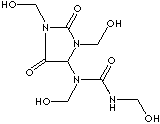PRODUCT IDENTIFICATION

H.S. CODE
TOXICITY
CLASSIFICATION
PHYSICAL AND CHEMICAL PROPERTIES
Very soluble
REFRACTIVE INDEX
Stable under ordinary conditions
APPLICATIONS
Formaldehyde is the simplest aldehyde with the formula HCH=O. It is a gas at room temperature with a pungent smell. It cannot be readily isolated or handled in the pure state because it is extremely reactive. Formaldehyde reversibly polymerizes to its cyclic trimer 1,3,5-trioxane or the linear polymer polyoxymethylene. It is readily oxidized to form formic acid in the air. It is commercially available as an aqueous solution usually 37-50% w/w. Formalin is the solution of formaldehyde in water. Paraformaldehyde is a white crystalline solid formed by polymerization of formaldehyde. Formaldehyde kills most bacteria, and used as a disinfectant and as a preservative and fixative for pathologic specimens. Formaldehyde cross links amino groups. In industry formaldehyde is used in the production of thermoset resins, functional polyols, explosive, hexamine and other chemicals. Examples of formaldehyde-releasing biocides are:
- Imidazolidinyl Urea (CAS RN: 39236-46-9)
- Diazolidinyl Urea (CAS RN: 78491-02-8)
- 1,3-Dimethylol-5,5-dimethylhydantoin (CAS RN: 6440-58-0)
- Bronopol (CAS RN: 52-51-7)
- Tris(hydroxymethyl)nitromethane (CAS RN: 126-11-4)
- Polyethylene glycol sorbitan monolaurate (CAS RN: 9005-64-5)
- Poly(acrylamide, trimethylaminoethyl methacrylate chloride) (CAS RN: 35429-19-7)
|
|
BIBLIOGRAPHY
USP24 / NF18
APPEARANCE
ASSAY